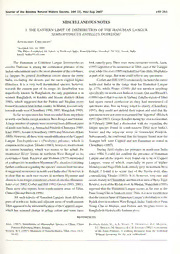Table Of ContentJournal of the Bombay Natural History Society, 104 (2), IMay-Aug 2007 199-253
MISCELLANEOUS NOTES
THE EASTERN LIMIT OF DISTRIBUTION OF THE HANUMAN LANGUR
1.
SEMNOPITHECUS ENTEEEUS DUFRESNE
1
Anwaruddin Choudhury2
'Accepted July 14, 2005
"The Rhino Foundation for Nature in North-east India, Bamunimaidam, Guwahati 781 021, Assam, India.
Email: [email protected]
The Hanuman or Common Langur Semnopithecus lookentirely grey. There were moreerroneousrecords.Anon.
entellus Dufresne is among the commonest primates of the (1997) reportedofits occurrence inTibet, eastoftheTsangpo
Indiansubcontinentandisthemostabundantofthecolobines, river,whileDasetal.(1995)includedEastGaroHills,Meghalaya
i.e. langurs. Its general distribution covers almost the entire aspartofitsrange. Butnone couldrefertoany specimens.
India, excluding the deserts and the snow-capped higher CorbetandHill 1992)erroneouslyincludedtheentire
(
Himalaya. It is a very well documented species; however, north-east India in the range map for Hanuman Langur
towards the eastern part of its range, its distribution was (p. 175), while Prater (1948) did not mention anything
imperfectly known. In Bangladesh, the only population is in specificallyonnorth-eastIndiaorAssam. Qiu andBleisch’s
western Bangladesh, in Kushtia and Jessore districts (Khan (1996)reportthatitoccursinYarlungZangburegionofTibet
1985), which suggested that the Padma and Meghna rivers had again raised confusion as they had mentioned of
formeditseasternlimitinthatcountry.InBhutan,itoccursonly specimens also. But on being asked to clarify (Choudhury
towardssouth-west(Choudhury 1990, 1997;Wangchuk 1995). 1997), they could not defend their report and said that the
Sofarnospecimenhasbeenrecorded fromanywhere specimenswerenotseenorexaminedbut ‘reported’ (Bleisch
innorth-eastIndiaexceptnorthernWestBengalandSikkim. 1997;Qiu 1997).GeorgeSchallerduringhisvisittoGuwahati
Alargenumberofreportswerereceivedfromdifferent parts in February 2000 had a discussion with me regarding the
ofnorth-eastIndia,e.g.ArunachalPradesh(Chatterjee 1989; langur species found in south-eastern Tibet near India’s
Kaul 1999),Assam(Choudhury 1989) andMizoram(Khali border and the adjacent areas in Arunachal Pradesh.
1995).However,alltheseweremisidentificationoftheCapped Subsequently, he confirmed that the langurs found nearthe
Langur Trachypithecus (=Presbytis) pileatus, which is Tsangpo belt were Capped and not Hanuman as stated in
commonintheregion.Tikader(1983),however,triedtolimit Choudhury(1997).
its eastern boundary, which was nearer to the actual. He During field studies for primates in north-east India
mentioned River Teesta in northern West Bengal as its since 1984, I could not confirm the presence of Hanuman
easternmost limit. Roonwal and Mohnot (1977) mentioned Langur and all the reports were found out to be ofCapped
ofasubspeciesinnorthernMyanmar(P.e. shanicus)creating Langurs, some of which, especially in parts of higher
furtherconfusionregardingthespecies’ easternlimitbecause HimalayaandNagaHillslookentirelygrey. InnorthernWest
itsuggestedoccurrenceinnorth-east Indiaalso! However,it Bengal, I found it to occur east of the Teesta river, thus
is clear that no such race occurs in northern Myanmar and contradicting Tikader (1983). It is, however, very rare and
shanicusisnolongerconsideredaformofentellus(Brandon- occursmainlyinChunabhatiandBuxafortareaofBuxaTiger
Jonesetal. 2002;CorbetandHill 1992;Groves 1993,2001). Reserve,westoftheRydakriver.InBhutan,Wangchuk(1995)
There were also reports from south-eastern areas ofTibet, reported that the Hanuman Langur occurs as far east as the
China(QiuandBleisch 1996). PunaTsangChuorSankoshriver.Thus,itisnowestablished
All such reports ofHanuman Langurs from different thattheeasternlimitofHanumanLangur’sdistributionisthe
parts ofnorth-eastIndia and adjacent areas ofsouth-eastern RydakriverinnorthernWestBengal,India;SankoshorPuna
TibetappearedtobemisidentificationoftheCappedLangur, Tsang Chu in Bhutan, and Padma and Meghna rivers in
whicli has seasonal change in pelage colour and some races Bangladesh(historicallyJamunaalso).
REFERENCES
Anon. (1997): Distribution of Mammalian Species in China. China Brandon-Jones, D., A.A. Eudey. T. Geissmann, D.J. Melnick,
ForestryPublishingHouse,Beijing. J.C.Morales,M. Shekelle&C.B. Stewart(2002):Ataxonomy
Bleisch,W.V.(1997): MammalsofNamchaBarwa,Tibet. Oryx31(2): oftheAsian Primates. Aworking documentfrom the workshop
91-92. “Primate taxonomy for the new millennium”.
MISCELLANEOUS NOTES
Chatterjee, A.K. (1989): Survey of Snow Leopard and associated Groves,C.P.(2001):PrimateTaxonomy.SmithsonianInstitutionPress,
animalsin MoulingNational park,east Siangdistrict,Arunachal Washington DC. 350 pp.
Pradesh.Arunachalforestnews 7(1 & 2): 10-15. Kaul, R. (1999): Arunachal: inquestofnature’s bounty.WWF-India,
Choudhury,A.U.(1989):PrimatesofAssam:theirdistribution,habitat New Delhi. 76pp.
and status. Ph.D. thesis. Gauhati University. 300pp. +maps. Khan,M.A.R.(1985): MammalsofBangladesh.N.Reza,Dhaka.92pp.
Choudhury, A.U. (1990): Primates in Bhutan. Oryx 24: 125. Khati, D. (1995): Dampa. SanctuaryAsia 15(2): 30-35.
Choudhury, A.U. (1997): Mammals of Namcha Barwa, Tibet. Oryx Prater, S.H. (1948): The Book of Indian Animals. Bombay Natural
31(2): 91. History Society and Oxford University Press, Bombay.
Corbet, G.B. & J.E. Hill (1992): The Mammals ofthe Indo-malayan Qiu. M.J. (1997): MammalsofNamchaBarwa,Tibet. Oryx31(2): 92.
Region: A Systematic review. Oxford University Press, Oxford. Qiu, M.J. & W.V. Bleisch (1996): Preliminary assessment of large
488 pp. mammals in the Namcha Barwa region of SE Tibet. Oryx 30:
Das, P, R. Ghose, T. Chakraborty, T. Bhattacharyya & M. Ghosh 31-36.
(1995):Mammalia.In:FaunaofMeghalaya.StateFaunaSeries4 Roonwal, M.L. & S.M. Mohnot (1977): Primates of South Asia:
(Part 1: vertebrates; Mammalia, pp. 23-128). Zoological Survey Ecology, Sociobiology & Behaviour. Harvard University Press,
ofIndia, Calcutta. Cambridge(Mass.).421 pp.
Groves, C.P (1993): Order Primates. Pp. 243-278. In: (Eds: Wilson, Tikader.B.K.(1983):ThreatenedAnimalsofIndia.ZoologicalSurvey
D.E.&D.M.Reeder)MammalSpeciesoftheWorld:ATaxonomic ofIndia, Calcutta. 307 pp.
&GeographicReference.2ndedn. SmithsonianInstitutionPress, Wangchuk, T. (1995): Acensus and the biogeography ofthe golden
Washington, D.C. & London. langur. Tigerpaper22(3): 1-6.
2. MACAQUES ‘KIDNAP’ INFANT PALM CIVETS1
SuSu2
‘Accepted September 09, 2005
2Zoology Department, Yangon University, Yangon, Myanmar. Email: [email protected]
During a study of Civet ecology in Hlawga Wildlife carnivore in the Park. We used food to coax the monkey to
Park(2000-2003), Iobservedtwoinstancesof ‘adoption' or surrenderthebabyCivet,butthemacaqueheldontoitfirmly.
‘kidnapping’ ofbaby Palm Civets. HlawgaWildlife Park in Whenwetriedchasing,itranawayandclimbedonatree,still
Myanmar is a 6.24 sq. km protected area, dominated by holding the baby. The Park’sforestry staffreportedthatthey
secondary mixed deciduous forest, located 35 km north of hadseenthemacaquewiththebabyCivetforthreedays.We
Yangon.TheParkhasamixedfaunaoflargemammals,such observed the macaque with the live baby Civetdaily forthe
asSambar(Cervusunicolor Hog Deer(Axisporcinus),Red nextthreedays,thebaby’svoicebecomingweakereachday.
),
Muntjac(Muntiacusmuntjak),Eld'sDeer(Cervuseldi),Wild Twodayslater,theCivetwasdeadbutwasstillbeingcarried
Boar(Sitsscrofa)andGaur(Bosfrontalis), someintroduced by the macaque.
from otherareas in Myanmar (Su Su 2003). It has a current Aweekafterthisevent,wesawanothermalemacaque,
population of c. 280 Rhesus Macaques (Macaco mulatto). a smaller male, carrying another baby Palm Civet. This
The Park is frequently visited by local tourists who feed infantCivetwasalivebutwasnotvocalizing. Unfortunately,
Sambar,HogDeer,Eld’sDeerandMacaqueswithfoodbought we were unable to observe this macaque on subsequent
fromlocalvendors. days. It seems probable that these macaques appropriate
OnApril22,2001, myassistantand Iwereapproached baby PalmCivets thattheyencounterincivetnestling sites,
byagroupofmacaquesseekingfood.Oneadultmalecarried in trees. Macaques are known to show paternal behaviour
a small black animal that was crying like akitten. We soon towardsinfantsoftheirownspecies(Schinoetal. 1995),but
identified it as an infant Palm Civet (Paradoxurus we have not heard of allo-mothering behaviour in this
hermaphroditus).ThePalmCivetisthemostcommonsmall species.
REFERENCES
Schino, G.. F.R. D'Amato & A. Trois (1995): Mother-infant relationships in Japanese macaques: sources of inter-individual variation.
Anim. Behav. 49: 151-158.
Su, Su (2003): The ecology of the small carnivore community in Hlawga Wildlife Park, Myanmar. Thesis submitted to Yangon University,
Myanmar for the degree ofDoctorof Philosophy in Wildlife Science and Conservation. 169 pp.
200 J. Bombay Nat. Hist. Soc., 104 (2), May-Aug 2007

